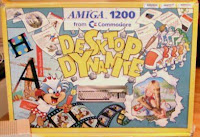Established in 1988, R.J Computers was a family owned and run computer business based in Downend, Bristol, and Between 1990 and the shop's closure some 14 years later this was my gaming mecca.
I first discovered R.J Computers (RJ's) when a flyer came through the door around late 1990 or early 1991. I'd not long had my Amiga, and was keen to make the most of it. With a specialist computer store only a short drive away from home this seemed to be a marriage made in heaven, and I wasn't wrong.
Back in the early 90s RJ's supported almost all the popular platforms - Spectrum, C64, Atari ST, Amiga, PC and SNES, to name but a few. Sure, an excellent range, but for me, this was 'the' place to go if you wanted to buy brand new Amiga games. They always stocked the latest titles, and they were slightly cheaper here than if you bought them at Game or Electronics Boutique.
As an Amiga owner I found RJ's to be an amazing place to visit. It was the place where I bought my 512k upgrade for my Amiga 500 (£39.99!), the place where, through a trade-in scheme, I part exchanged my A500 for a brand new A1200. I bought my first A1200 RAM expansion from RJ's, and experienced the joys of entering the CDROM revolution, when I purchased a Zappo CDROM drive (£225 for a 2x CDROM!) from there.
The staff were fantastic. They were always on hand to give advice, and nothing ever seemed to be too much trouble. One Christmas I received a Commodore inkjet printer, but no matter what we tried my father and I couldn't get it to work properly. We took it down to RJ's, and even though we'd not bought it from there they hooked it up to one of their Amiga systems and spent a good 40 minutes troubleshooting it until they'd got it working. All this was completely free of charge. How many places would offer that kind of service these days?
Following the demise of Commodore in 1994 RJ's started to move away from the Amiga, and concentrate on the blossoming PC market. They started selling their own custom built machines, and although they may have been slightly more expensive than the online retailers, you knew that if anything went wrong with yours or you had a problem they'd be more than happy to take a look at it.
In 1998 the company I work for set up a scheme where you could purchase components to build your own PC through the business, where you'd have access to massively cheaper components than if they were bought from a high street shop, and you could pay the cost back over a period of 12 months.
With a decent PC costing over £1000 back then this seemed like the best way for me to move away from the dying Amiga market, and so I jumped ship, bought the components, built my own computer and packed up my trusty A1200.
Over the next few years I still popped in to RJ's every now and then. I didn't purchase much - perhaps the odd adapter here, the odd cable there. The place was full of PC systems by this point, and while the staff were as friendly and chatty as ever, the excitement I used to get when walking through the door of the place just wasn't there anymore. The hustle and bustle had also gone. What was a heaving haven for 8 and 16 bit gamers some 7 or 8 years prior was now a place where often I'd be the only customer in there.
In early summer 2004 I had the need to pop in to RJ's again. I was after something for a PC I was building, and I didn't want to order it online and have to wait for it to arrive. It'd been a good 12 months since I'd last popped in there, and I was quite looking forward to seeing the place and catching up with the staff.
I parked up outside the shop, got out, and was gobsmacked. The RJ's I'd known was gone, and in it's place was a fish and chip shop. I can only assume that the electronic retail chains and online stores had been the nail in the coffin. Others like me had no doubt found that items could be purchased online from the comfort of your desk and a couple of mouse clicks. It was easy, and often it was cheaper, too.
Stunned, I got back into the car and made my way home. "Perhaps they've just moved", I said to myself, and so I decided to go on to their web site to see if that had more information on the closure.
The site had been updated, but the news wasn't good:
As of the 12th June 2004 R.J.Computers has closed.
We would like to express our thanks to all our customers who have used our services and supported us over the years.
I'll never forget those Saturday's driving (or being driven, when I was too young to drive myself!) down to RJ's. Most of the time I wasn't going down for anything particular. I simply enjoyed the buzz of getting down there and wondering what new hardware or software they'd have in stock.
It's clear I'm not the only person who has fond memories of visiting their local computer shop, as this thread over on the English Amiga Board shows.
With the rise of the online stores offering massive discounts compared to your bricks and mortar independent, I can't ever see the days of the indie returning. It's sad really, as they offered something the online stores never will be able to - service with a smile and help that was second to none.


































